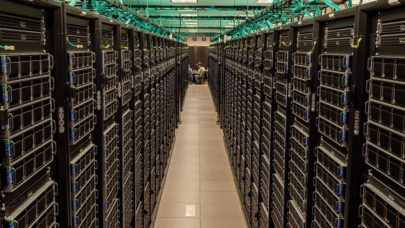
HPCwire Unveils Editors’ Superlative Awards
February 14, 2023
Each November, HPCwire’s readers and editors recognize dozens of individuals and organizations across more than 20 very serious award categories, celebrating Read more…

TACC Adds Details to Vision for Leadership-Class Computing Facility
May 23, 2022
The Texas Advanced Computing Center (TACC) at The University of Texas at Austin passed to the next phase of the planning process for the Leadership-Class Computing Facility (LCCF), a process that has many approval stages and will take about four more years. If ultimately awarded for construction, the LCCF will serve as the leading facility for advanced computing for the U.S. academic open science community... Read more…

TACC Looks to ‘Horizon’ System for Its Leadership-Class Computing Facility
April 14, 2022
During a talk for the Ken Kennedy Institute’s 2022 Energy High Performance Computing Conference, Dan Stanzione, executive director of the Texas Advanced Compu Read more…

Argonne Researchers Use AI-Enabled Supercomputing for COVID-19 Drug Discovery
April 24, 2020
The world’s supercomputers are engaged in an urgent scavenger hunt, poring over as many molecules as possible in the hopes of finding one that bonds to COVID- Read more…

New HPC-Enabled COVID-19 Model Corrects ‘Critical Statistical Flaws’ with IHME Model
April 23, 2020
The United States is waiting with bated breath to see its crucial coronavirus curves – daily cases, hospitalizations, and deaths – flatten, peak and begin t Read more…

TACC Simulates Dangers of Low Earth Orbit to Astronauts
April 4, 2018
Much remains unknown about the hazards the space environment will present to future space travelers. Recent simulations conducted by researchers from Texas A&am Read more…

New Approach to Computationally Designing Drugs for GPCRs
September 8, 2016
Modeling protein interactions with drugs has long been computationally challenging. One obstacle is these interactions often take relatively long to occur and conventional molecular dynamics simulation is insufficient. This week a group of researchers, using several EXSEDE supercomputers, report a hybrid in silico-experimental approach that shows promise as a drug design tool for use with G protein-coupled receptors (GPCRs) Read more…

TACC Director Lays Out Details of 2nd-Gen Stampede System
June 2, 2016
With a $30 million award from the National Science Foundation announced today, the Texas Advanced Computing Center (TACC) at The University of Texas at Austin (UT Austin) will stand up a second-generation Stampede system based on Dell PowerEdge servers equipped with Intel "Knights Landing" processors, next-generation Xeon chips and future 3D XPoint memory. Read more…

- Click Here for More Headlines

Whitepaper
Transforming Industrial and Automotive Manufacturing
In this era, expansion in digital infrastructure capacity is inevitable. Parallel to this, climate change consciousness is also rising, making sustainability a mandatory part of the organization’s functioning. As computing workloads such as AI and HPC continue to surge, so does the energy consumption, posing environmental woes. IT departments within organizations have a crucial role in combating this challenge. They can significantly drive sustainable practices by influencing newer technologies and process adoption that aid in mitigating the effects of climate change.
While buying more sustainable IT solutions is an option, partnering with IT solutions providers, such and Lenovo and Intel, who are committed to sustainability and aiding customers in executing sustainability strategies is likely to be more impactful.
Learn how Lenovo and Intel, through their partnership, are strongly positioned to address this need with their innovations driving energy efficiency and environmental stewardship.
Download Now
Sponsored by Lenovo
Whitepaper
How Direct Liquid Cooling Improves Data Center Energy Efficiency
Data centers are experiencing increasing power consumption, space constraints and cooling demands due to the unprecedented computing power required by today’s chips and servers. HVAC cooling systems consume approximately 40% of a data center’s electricity. These systems traditionally use air conditioning, air handling and fans to cool the data center facility and IT equipment, ultimately resulting in high energy consumption and high carbon emissions. Data centers are moving to direct liquid cooled (DLC) systems to improve cooling efficiency thus lowering their PUE, operating expenses (OPEX) and carbon footprint.
This paper describes how CoolIT Systems (CoolIT) meets the need for improved energy efficiency in data centers and includes case studies that show how CoolIT’s DLC solutions improve energy efficiency, increase rack density, lower OPEX, and enable sustainability programs. CoolIT is the global market and innovation leader in scalable DLC solutions for the world’s most demanding computing environments. CoolIT’s end-to-end solutions meet the rising demand in cooling and the rising demand for energy efficiency.
Download Now
Sponsored by CoolIT
Advanced Scale Career Development & Workforce Enhancement Center
Featured Advanced Scale Jobs:
HPCwire Resource Library
HPCwire Product Showcase
© 2024 HPCwire. All Rights Reserved. A Tabor Communications Publication
HPCwire is a registered trademark of Tabor Communications, Inc. Use of this site is governed by our Terms of Use and Privacy Policy.
Reproduction in whole or in part in any form or medium without express written permission of Tabor Communications, Inc. is prohibited.
























